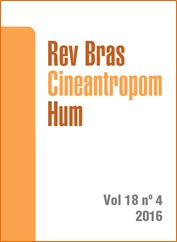Desenvolvimento do equilíbrio postural em crianças brasileiras de 4 a 10 anos de idade comparadas com adultos-jovens
DOI:
https://doi.org/10.1590/1980-0037.2016v18n4p419Resumo
O objetivo do presente trabalho foi analisar o desenvolvimento do equilíbrio postural de crianças brasileiras de 4 a 10 anos de idade, comparar com um grupo de adultos-jovens, com o uso da visão normal e na ausência da visão. A oscilação corporal foi avaliada por meio da velocidade media e amplitude de oscilação do centro de pressão (CoP) nas direções ântero-posterior e médio-lateral, obtidas por meio de uma plataforma de força (AMTI, Inc.). O grupo de estudo foi composto por 153 crianças (de sete diferentes grupos etários) e 47 adultos-jovens. As comparações inter-grupos foram feitas com o uso dos testes ANOVA one-way e o post-hoc de Tukey com um nível de significância de 5%. Os resultados mostraram que por volta de 9 e 10 anos de idade os valores da velocidade e da amplitude de deslocamento do CoP passam a ser similares entre crianças e adultos-jovens; no entanto, com a restrição do uso da visão, houve diferenças entre crianças e adultos-jovens. Os achados sugerem que o estimulo visual tem um papel importante no equilíbrio postural de indivíduos até os seus 10 anos de idade, com significativas evidencias que o controle postural não está totalmente desenvolvido até essa faixa etária.
Downloads
Publicado
Edição
Seção
Licença

Direitos Autorais para artigos publicados nesta revista são do autor, com direitos de primeira publicação para a revista. Em virtude da aparecerem nesta revista de acesso público, os artigos são de uso gratuito, com atribuições próprias, em aplicações educacionais e não-comerciais, desde que seja dada a atribuição. Esta obra foi licenciada com uma Licença Creative Commons Atribuição 4.0 Internacional - CC BY


